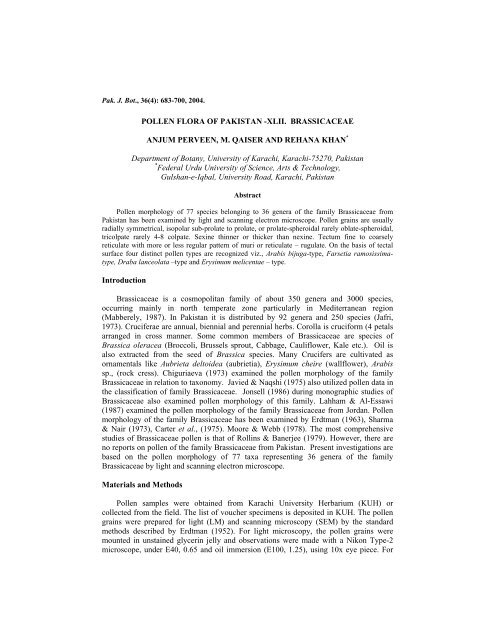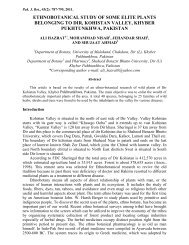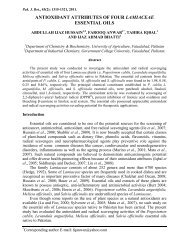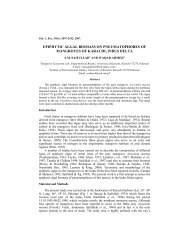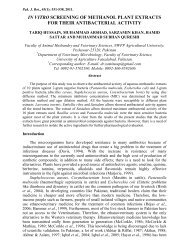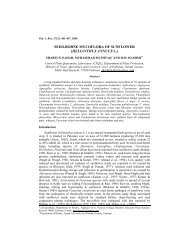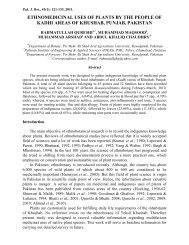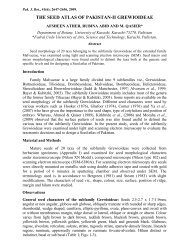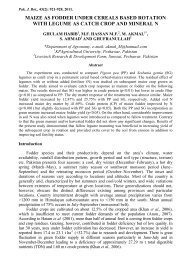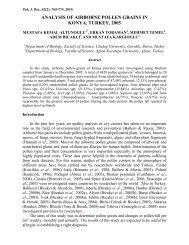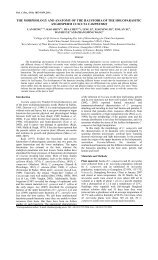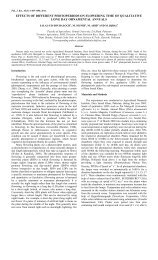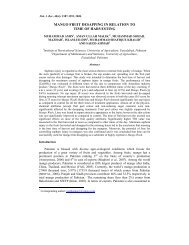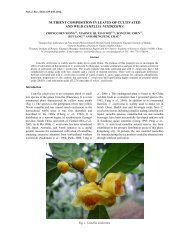POLLEN FLORA OF PAKISTAN -XLII. BRASSICACEAE ANJUM ...
POLLEN FLORA OF PAKISTAN -XLII. BRASSICACEAE ANJUM ...
POLLEN FLORA OF PAKISTAN -XLII. BRASSICACEAE ANJUM ...
Create successful ePaper yourself
Turn your PDF publications into a flip-book with our unique Google optimized e-Paper software.
Pak. J. Bot., 36(4): 683-700, 2004.<br />
<strong>POLLEN</strong> <strong>FLORA</strong> <strong>OF</strong> <strong>PAKISTAN</strong> -<strong>XLII</strong>. <strong>BRASSICACEAE</strong><br />
<strong>ANJUM</strong> PERVEEN, M. QAISER AND REHANA KHAN *<br />
Department of Botany, University of Karachi, Karachi-75270, Pakistan<br />
* Federal Urdu University of Science, Arts & Technology,<br />
Gulshan-e-Iqbal, University Road, Karachi, Pakistan<br />
Abstract<br />
Pollen morphology of 77 species belonging to 36 genera of the family Brassicaceae from<br />
Pakistan has been examined by light and scanning electron microscope. Pollen grains are usually<br />
radially symmetrical, isopolar sub-prolate to prolate, or prolate-spheroidal rarely oblate-spheroidal,<br />
tricolpate rarely 4-8 colpate. Sexine thinner or thicker than nexine. Tectum fine to coarsely<br />
reticulate with more or less regular pattern of muri or reticulate – rugulate. On the basis of tectal<br />
surface four distinct pollen types are recognized viz., Arabis bijuga-type, Farsetia ramosissimatype,<br />
Draba lanceolata –type and Erysimum melicentae – type.<br />
Introduction<br />
Brassicaceae is a cosmopolitan family of about 350 genera and 3000 species,<br />
occurring mainly in north temperate zone particularly in Mediterranean region<br />
(Mabberely, 1987). In Pakistan it is distributed by 92 genera and 250 species (Jafri,<br />
1973). Cruciferae are annual, biennial and perennial herbs. Corolla is cruciform (4 petals<br />
arranged in cross manner. Some common members of Brassicaceae are species of<br />
Brassica oleracea (Broccoli, Brussels sprout, Cabbage, Cauliflower, Kale etc.). Oil is<br />
also extracted from the seed of Brassica species. Many Crucifers are cultivated as<br />
ornamentals like Aubrieta deltoidea (aubrietia), Erysimum cheire (wallflower), Arabis<br />
sp., (rock cress). Chiguriaeva (1973) examined the pollen morphology of the family<br />
Brassicaceae in relation to taxonomy. Javied & Naqshi (1975) also utilized pollen data in<br />
the classification of family Brassicaceae. Jonsell (1986) during monographic studies of<br />
Brassicaceae also examined pollen morphology of this family. Lahham & Al-Essawi<br />
(1987) examined the pollen morphology of the family Brassicaceae from Jordan. Pollen<br />
morphology of the family Brassicaceae has been examined by Erdtman (1963), Sharma<br />
& Nair (1973), Carter et al., (1975). Moore & Webb (1978). The most comprehensive<br />
studies of Brassicaceae pollen is that of Rollins & Banerjee (1979). However, there are<br />
no reports on pollen of the family Brassicaceae from Pakistan. Present investigations are<br />
based on the pollen morphology of 77 taxa representing 36 genera of the family<br />
Brassicaceae by light and scanning electron microscope.<br />
Materials and Methods<br />
Pollen samples were obtained from Karachi University Herbarium (KUH) or<br />
collected from the field. The list of voucher specimens is deposited in KUH. The pollen<br />
grains were prepared for light (LM) and scanning microscopy (SEM) by the standard<br />
methods described by Erdtman (1952). For light microscopy, the pollen grains were<br />
mounted in unstained glycerin jelly and observations were made with a Nikon Type-2<br />
microscope, under E40, 0.65 and oil immersion (E100, 1.25), using 10x eye piece. For
684<br />
<strong>ANJUM</strong> PERVEEN ET AL.,<br />
SEM studies, pollen grains suspended in a drop of water were directly transferred with a<br />
fine pipette to a metallic stub using double sided cello tape and coated with gold in a<br />
sputtering chamber (Ion-sputter JFC-1100). Coating was restricted to 150 A. The S.E.M<br />
examination was carried out on a Jeol microscope JSM-2. The measurements are based<br />
on 15-20 readings from each specimen. Pollen diameter, polar axis (P) and equatorial<br />
diameter (E), aperture size, apocolpium, mesocolpium and exine thickness were<br />
measured (Tables 1-4).<br />
The terminology used is in accordance with Erdtman (1952), Kremp (1965), Faegri<br />
& Iversen (1964) and Walker & Doyle (1975).<br />
General pollen characters of the family Brassicaceae<br />
Pollen grains usually radially symmetrical, isopolar, sub-prolate or prolate to prolatespheroidal,<br />
rarely oblate-spheroidal, tricolpate often 4-8 colpate. Sexine thinner or thicker<br />
than nexine. Tectum fine to coarse reticulate or reticulate-rugulate. On the basis of tectum<br />
types, four distinct pollen types are recognized viz., Arabis bijuga-type, Farsetia<br />
ramosissima-type, Draba lanceolata – type and Erysimum melicentae - type.<br />
Key to the pollen types<br />
1. + Tectum reticulate-rugulate ..…………….…………… Farsetia ramosissima-type<br />
- Tectum fine-coarse reticulate ……….…………………………………………... 2<br />
2. + Tectum finely reticulate ……………………………………... Arabis bijuga-type<br />
- Tectum not as above ………………………………….………………………… 3<br />
3. + Tectum medium reticulate .…………………………. Erysimum melicentae - type<br />
Tectum coarsely reticulate…………………………...….. Draba lanceolata –type<br />
Pollen type: Arabis bijuga - type (Fig. 1 A-C)<br />
Pollen class: Tricolpate<br />
P/E ratio: 108-140<br />
Shape: Prolate-spheroidal to sub-prolate rarely prolate.<br />
Apertures: Colpus long sunken with acute ends.<br />
Exine: Sexine thicker than nexine.<br />
Ornamentation: Finely reticulate more or less regular pattern of muri.<br />
Measurements: Size: Polar axis P=16 (25.5) 32.5 μm and equatorial diameter E=15<br />
(21.5) 28 μm, trilobed, with apertures on the angles of the outline of the grain in polar<br />
view, colpi 10 (15.5) 20 μm long. Exine 1.0 (1.5) 2.5 μm thick, sexine as thick as nexine.<br />
Tectum finely reticulate.<br />
Species included: Arabidopsis mollissima (C.A. Mey) Busch, A. traxacifolia (T.And.)<br />
Jafri, Arabidopsis wallichii (Hook.f. Thoms.) Busch, A. stricta (Camb.) Busch., Arabis<br />
amlpexicaule Edgew., A. bijuga Watt., A. pterosperma Edgew, Bassica juncea (L.)<br />
Czern., B. napus L.ssp. napus, B. nigra (L.) Koch., B. oleracea var. botrytis L., B.<br />
oleracea var. capitata, B. rapa ssp. rapa, B. rapa ssp. campestris, Cardamine impatiens<br />
L., Chorispora sibirica (L.) DC., Douepia tortuosa Camb., Drabopsis verna Koch.,<br />
Euclidium syriacum (L.) R.Br., Malcolmia scorpioides (Bunge) Boiss.
<strong>POLLEN</strong> <strong>FLORA</strong> <strong>OF</strong> <strong>PAKISTAN</strong> -<strong>XLII</strong> <strong>BRASSICACEAE</strong><br />
685
686<br />
<strong>ANJUM</strong> PERVEEN ET AL.,
<strong>POLLEN</strong> <strong>FLORA</strong> <strong>OF</strong> <strong>PAKISTAN</strong> -<strong>XLII</strong> <strong>BRASSICACEAE</strong><br />
687
688<br />
<strong>ANJUM</strong> PERVEEN ET AL.,
<strong>POLLEN</strong> <strong>FLORA</strong> <strong>OF</strong> <strong>PAKISTAN</strong> -<strong>XLII</strong> <strong>BRASSICACEAE</strong><br />
689
690<br />
<strong>ANJUM</strong> PERVEEN ET AL.,
<strong>POLLEN</strong> <strong>FLORA</strong> <strong>OF</strong> <strong>PAKISTAN</strong> -<strong>XLII</strong> <strong>BRASSICACEAE</strong><br />
Key to the species and group<br />
1. + Pollen grains prolate-spheroidal ……..……………… Douepia tortuosa - subtype<br />
(Arabis pterosperma, Doupia tortuosa, Bassica juncea, Brassica napus ssp.<br />
napus, B. nigra, B. rapa ssp. rapa)<br />
- Pollen grains sub-prolate to prolate …………………………………………….. 2<br />
2. + Pollen grains subprolate ………………………. Arabidopsis mollissima- subtype<br />
(Arabidopsis mollissima, A. traxacifolia, Arabis amlpexicaule, A. bijuga,<br />
Brassica oleracea var. capitata, B. rapa ssp. campestris, Cardamine impatiens,<br />
Chorispora sibirica, Drabopsis verna, Euclidium syriacum Malcolmia<br />
scorpioides)<br />
- Pollen grains prolate …..…………….…………… Arabidopsis wallichii-subtype<br />
(Arabidopsis wallichii, A. stricta, Brassica oleracea var. botrytis L.)<br />
Pollen type: Erysimum melicentae (Fig. 1D-F. Fig. 2 A & B).<br />
Pollen class: Tricolpate<br />
P/E ratio: 110-151<br />
Shape: Sub-prolate to prolate rarely prolate-spheroidal<br />
Apertures: Colpus long sunken with acute ends.<br />
Exine: Sexine thicker or thinner than nexine.<br />
Ornamentation: Medium reticulate with more or less regular pattern of muri.<br />
Measurements: Size: Polar axis P=16 (24.5) 32.5 μm and equatorial diameter E=15<br />
(21.5) 32 μm, (trilobed, with apertures on the angles of the outline of the grain in polar<br />
view, colpi 10 (15.5) 17.5 μm long. Exine 1.0 (1.96) 2.5 μm thick, sexine as thick as<br />
nexine. Tectum medium reticulate.<br />
Species included: Alliaria petiolata (M.Bieb.) Cav. Grande, Arabis saxicola Edgew,<br />
Alyssum desertorum Staph, Arabidopsis pumila (Steph) Busch, Cardaria drapa (L.)<br />
Desv,. Cithareloma lehmannii Bunge, Coronocarpus didymus (L.) Smith, Diceratella<br />
canescens (Boiss.) Boiss., Goldbachia laevigata (M.Bieb.) DC. Eremobium aegypticum<br />
(Spreng) Boiss., Leptaleum filifolium (Willd.) DC., Malcolima strigosa Boiss.<br />
Key to the species and group<br />
1. + Pollen grains prolate-spheroidal ……………………………. Goldbachia laevigata<br />
- Pollen grains sub-prolate to prolate …………………………...…………………. 2<br />
2. + Pollen grains prolate .…………………………...… Alyssum desertorum-sub-type<br />
(Alyssum desertorum, Arabis saxicola, Arbidopsis pumila, Cardaria drapa)<br />
- Pollen grains sub-prolate …………………………… Alliaria petiolata –subtype<br />
(Alliaria petiolata, Cithareloma lehmannii, Coronocarpus didymus, Diceratella<br />
canescens, Goldbachia laevigata, Eremobium aegypticum, Leptaleum filifolium,<br />
Malcolima strigosa)<br />
Pollen type: Draba lanceolata- type (Fig. 2 C-F; Fig. 3A-F; Fig. 4A-F)<br />
Pollen class: Tricolpate<br />
P/E ratio: 106-168<br />
Shape: Prolate to subprolate rarely prolate-spheroidal<br />
691
692<br />
<strong>ANJUM</strong> PERVEEN ET AL.,<br />
Fig. 1. Scanning Electron micrographs of pollen grains. Arabis bijuga: A, Equatroial view, B, Exine pattern. A.<br />
pterosperma: C, Polar view. Leptaleum filifolium: D, Equatorial view. Cithareloma lehmannii: E, polar view,<br />
F, Exine pattern. Scale bar = A, C, D & E = 10; B, F = 1 μm
<strong>POLLEN</strong> <strong>FLORA</strong> <strong>OF</strong> <strong>PAKISTAN</strong> -<strong>XLII</strong> <strong>BRASSICACEAE</strong><br />
Fig. 2. Scanning Electron micrographs of pollen grains. Leptaleum filifolium: A, Exine pattern. Eremobium<br />
aegypticum: B, pollen grains. Isatis minima: C, Equatroial view, D, Exine pattern. Capsella burspastoris: E.,<br />
Polar view, F, Exine pattern. Scale bar =B, C & E = 10; A, D & F = 1 μm<br />
693
694<br />
<strong>ANJUM</strong> PERVEEN ET AL.,<br />
Fig. 3. Scanning Electron micrographs of pollen grain. Boreava orientalis: A, Equatorial view. Euclidium<br />
tenuissimum: B, Equatorial view, C, Exine pattern. Farsetia hamiltonii: D, Exine pattern, E, Equatorial view.<br />
Alyssum desertorum: F, Exine pattern. Scale bar = A , B & E = 10; C, D & F = 1 μm
<strong>POLLEN</strong> <strong>FLORA</strong> <strong>OF</strong> <strong>PAKISTAN</strong> -<strong>XLII</strong> <strong>BRASSICACEAE</strong><br />
Fig. 4. Scanning Electron micrographs of pollen grains. Draba stenocarpa: A, Exine pattern, B, Equatorial<br />
view. Draba trinervia: C, Polar view. Christolea himalayensis: D, Equatorial view, E, Exine pattern. Barbrea<br />
intermidia: F, Equatorial view. Scale bar = B –D & F= 10; A & E = 1 μm<br />
695
696<br />
<strong>ANJUM</strong> PERVEEN ET AL.,<br />
Apertures: Colpus long sunken with acute ends.<br />
Exine: Sexine thicker than nexine.<br />
Ornamentation: Coarsely reticulate.<br />
Measurements: Size: Polar axis P=16 (27.5) 39.5 μm and equatorial diameter E=16<br />
(18.5) 22.1 μm, (trilobed, with apertures on the angles of the outline of the grain in polar<br />
view, colpi 10 (21.5) 32.5 μm long. Exine 1.5 (2) 2.5 μm thick, sexine as thick as nexine.<br />
Tectum coarsely reticulate.<br />
Species included: Alyssum desertorum Staph, Boreava orientalis Jaub. & Spach,<br />
Capsella bursa-pastoris (L.) Medik., Chorispora bungeana Fish & Mey, Christolea<br />
himalayensis (Camb.) Jafri, Chorispora tenella (Pallas) DC., Draba trinervis Schultz, D.<br />
altaica (C.A. Mey) Bunge, D. lanceolata Royle, D. melanopus Kom., D. stenocarpa<br />
Hook. F. & Thoms. Euclidium tenuissimum (Pallas) B. Fedtsch., Erysimum meilicentae<br />
Dunn., E. griffithianum Boiss, Farsetia hamiltonii Royle, Diceratella floccose (Boiss.)<br />
Boiss., Farsetia heliophila Bunge ex Coss., Isatis stocksii Rech.f Boiss, I. minima<br />
Bunge, Lepidium virginicum L, Matthiola macranica Rech f., Mathiola flavida Boiss.,<br />
Malcolmia cabulica (Boiss.) Hook. F. Thoms, Malcolmia africana (L.) R.Br., Nasturtium<br />
officinale R. Br., Microsisymbrium flaccidum Schulz.<br />
Key to the species and group<br />
1. + Pollen grains prolate-spheroidal ..……………….…………Isatis stocksii-subtype<br />
(Isatis stocksii, Isatis minima)<br />
- Pollen grains not as above ………………………………………………………. 2<br />
2. + Pollen grains prolate …………………………. Capsella bursa-pastoris. -subtype<br />
(Capsella bursa-pastoris, Boreava orientalis, Chorispora tenella, Malcolmia<br />
cabulica)<br />
- Pollen grains sub-prolate ………………………… Matthiola macranica-subtype<br />
(Chorispora bungeana, Christolea himalayensis, Draba trinervis, D. altaica, D.<br />
lanceolata, D. melanopus, D. stenocarpa, Euclidium tenuissimum, Erysimum<br />
meilicentae, E. griffithianum, Farsetia hamiltonii, Diceratella floccose, Farsetia<br />
heliophila, Lepidium virginicum, Matthiola macranica, Matthiola flavida,<br />
Malcolmia africana, Nasturtium officinale, Microsisymbrium flaccidum)<br />
Pollen type: Farsetia ramosissima - type (Fig. 5 A-G)<br />
Pollen class: Tricolpate<br />
P/E ratio: 102-113<br />
Shape: Sub-prolate to prolate-spheroidal rarely prolate.<br />
Apertures: Colpus long sunken with acute ends.<br />
Exine: Sexine thicker than nexine.<br />
Ornamentation: Reticulate – rugulate.<br />
Measurements: Size: Polar axis P = 14 (23.5) 32.5 μm and equatorial diameter E=12<br />
(18) 24 um, trilobed, with apertures on the angles of the outline of the grain in polar view,<br />
colpi 8.75 (16.5) 25.5 μm long. Exine 1.5 (2) 2.5 μm thick, sexine as thick as nexine.<br />
Tectum reticulate-rugulate.<br />
Species included: Barbaraea vulgaris, Conringia planisiliqua Fisch & Mey., Crambe<br />
cardifolia Steven, Descurainia sophia (L.) Webb. & Berth., Diplotaxis griffithii (Hook. f.
<strong>POLLEN</strong> <strong>FLORA</strong> <strong>OF</strong> <strong>PAKISTAN</strong> -<strong>XLII</strong> <strong>BRASSICACEAE</strong><br />
Fig. 5. Scanning Electron micrographs of pollen grains. Diplotaxis harra: A, Polar view, D. grifithii: B,<br />
Equatorial view, C, Exine pattern. Crambe cordifolia: D, Polar view. Conringia planisliqua: E, Equatorial view,<br />
F, Exine pattern, G, Polar view. Scale bar = A, B, D, E & G = 10; C & F = 1 μm<br />
697
698<br />
<strong>ANJUM</strong> PERVEEN ET AL.,<br />
& Thoms.) Boiss., Diptychocarpus strictus (Fish.M.Beib.) Trautv, Diplotaxis harra<br />
(Forssk.) Boiss, Erysimum crassicaule (Boiss.) Boiss., Erysimum melicentae Dunn., E.<br />
repandum L., Farsetia ramosissima Hochst. ex Boiss., Malcolmia behboudiana Rech.f.,<br />
Moricandia sinaica (Boiss.) Boiss. Lepidium aucheri Boiss., Isatis costata C.A.Mey<br />
Key to the species and group<br />
1. + Pollen grains oblate-spheroidal………………………..……………..Isatis costata<br />
- Pollen grains prolate-spheroidal or prolate to sub-prolate ……………………… 2<br />
2. + Pollen grains prolate …………………………….. Erysimum crassicaule-subtype<br />
(Erysimum crassicaule,E. repandum, Barbaraea vulgaris)<br />
- Pollen grains sub-prolate …..…………..…………… Diplotaxis griffithii-subtype<br />
(Conringia planisiliqua, Crambe cardifolia, Descurainia sophia, Diplotaxis<br />
griffthii, Diptychocarpus strictus, Diplotaxis harra, Erysimum crassicaule,<br />
Erysimum melicentae, E. repandum, Farsetia ramosissima, Malcolmia<br />
behboudiana, Moricandia sinaica, Lepidium aucheri)<br />
Discussion and Conclusions<br />
Brassicaceae is a stenopalynous family (Erdtman, 1952). Pollen grains are generally<br />
prolate to sub-prolate or prolate – spheroidal rarely oblate – spheroidal, 3 - colpate often<br />
4-8 –colpate as in Erysimum stocksiana. Tectum reticulate, reticulum varies from fine –<br />
coarse. Appel & Al-Shehbaz (2003) also reported tricolpate reticulate pollen in the family<br />
Brassicaceae. However, they reported sparsely spinulose and punctate tectum in the<br />
genus Heliophila and 10-colpate pollen in few genera of Brassicaceae. Erdtman (1963)<br />
divided the species of Brassicaceae into two pollen types on the bases of exine thickness.<br />
Moore & Webb (1987) classified the family in tricolpate with reticulate pollen. Khalik<br />
(2002) divided the family into three pollen types on the basis of lumina size. The generic<br />
delimitation based on pollen morphology is difficult. However, on the basis of tectal<br />
surface four distinct pollen types are recognized viz., Arabis bijuga – type, Erysimum<br />
melicentae - type, Farsetia ramosissima - type, Draba lanceolate - type. The Arabis<br />
bijuga – type is easily recognized by having finely reticulate pollen, 20 species are<br />
included in this pollen type viz., Arabidopsis mollissima (C.A. Mey) Busch, A.<br />
traxacifolia (T.And.) Jafri, Arabidopsis wallichii (Hook. f. Thoms.) Busch, A. stricta<br />
(Camb.) Busch., Arabis amlpexicaule Edgew., A. bijuga Watt., Arabis pterosperma<br />
Edgew, Brassica juncea (L.) Czern., B. napus L., ssp., napus, B. nigra (L.) Koch., B.<br />
oleracea var. botrytis L., B. oleracea var. capitata, B. rapa ssp. rapa, B. rapa ssp.,<br />
campestris. Cardamine impatiens L., Chorispora. sibirica (L.) DC., Douepia tortuosa<br />
Camb., Drabopsis verna, Euclidium syriacum (L.) R.Br., Malcolmia. scorpioides<br />
(Bunge) Boiss. This pollen type is further divided into three subtypes on the basis of<br />
pollen shape classes (see key to the species or species group). Erysimum melicentae –<br />
type is delimited by its medium reticulate tectum, 12 species have medium reticulate<br />
tectum such as Alyssum desertorum Staph, Alliaria petiolata (M.Bieb.) Cav. Grande,<br />
Arabis saxicola Edgew, Arbidopsis pumila (Steph) Busch, Cardaria drapa, Cithareloma<br />
lehminniii, Coronocarpus didymus (L.) Smith, Diceratella canescens (Boiss.) Boiss.,<br />
Goldbachia laevigata (M.Bieb.) DC., Eremobium aegypticum (Spreng) Boiss., Erysimum<br />
melicentae Dunn., E. repandum L., E. griffithianum Boiss., Leptaleum filifolium (Willd.)
<strong>POLLEN</strong> <strong>FLORA</strong> <strong>OF</strong> <strong>PAKISTAN</strong> -<strong>XLII</strong> <strong>BRASSICACEAE</strong><br />
DC., Malcolima. strigosa Boiss. This type also divided into two subtype based on pollen<br />
shape class (see key to the species and species group). Draba lanceolata- type is the<br />
largest among all the four pollen types (28 species). This pollen type is characterized by<br />
its coarsely reticulate tectum. viz., Alyssum desertorum Staph, Boreava orientalis Jaub. &<br />
Spach, Capsella bursa-pastoris (L.) Medik., Chorispora bungeana Fish & Mey,<br />
Christolea himalayensis (Camb.) Jafri, Chorispora tenella (Pallas) DC., Draba trinervis<br />
Schultz, D. altaica (C.A. Mey) Bunge, D. lanceolata Royle, D. melanopus Kom., D.<br />
stenocarpa Hook. F. & Thoms., Euclidium tenuissimum (Pallas) B. Fedtsch, Erysimum<br />
melicentae Dunn., E. griffithianum Boiss., Farsetia hamiltonii Royle, Diceratella<br />
floccose (Boiss.) Boiss., Farsetia heliophila Bunge ex Coss., Isatis stocksii Rech.f<br />
Boiss, I. minima Bunge, Lepidium virginicum L, Matthiola macranica Rech f., Matthiola<br />
flavida Boiss., Malcolmia africana (L.) R.Br., Nasturtium officinale R. Br.,<br />
Microsisymbrium flaccidum Schulz,. It is also divided into three subtype (see key to the<br />
species). Farsetia ramosissima - type is easily distinguished by its reticulate – rugulate<br />
tectum. Jonsell (1987) reported similar pollen in the genus Farsetia 13 species are<br />
included in this pollen type like, Conringia planisiliqua Fisch & Mey., Crambe<br />
cardifolia Steven, Descurainia sophia (L.) Webb. & Berth., Diplotaxis grifftihii (Hook.)<br />
& Thoms. Boiss., Diptychocarpus strictus (Fish. M. Beib.) Trautv, Diplotaxis harra<br />
(Forssk.) Boiss, Erysimum crassicaule (Boiss.) Boiss. Erysimum melicentae Dunn., E.<br />
repandum L., Farsetia ramosissima Hochst. ex Boiss, Malcolmia behboudiana, Rech.f.,<br />
Moricandia sinaica (Boiss.) Boiss. Lepidium aucheri Boiss. Like other three types this<br />
pollen type is also classified into two subtypes<br />
Pollen morphologically the family is more closely related to Tamricaceae where both<br />
families have tricolpate pollen with reticulate tectum (Qaiser & Perveen, 2004). Ertdman<br />
(1952) reported that the family is more close to family Capparaceae. However,<br />
Capparaceae is eurypalynous family, in this family tricolporate pollen are common<br />
(Perveen & Qaiser, 2001). Pollen morphology confirms the homogeneous nature of the<br />
family.<br />
References<br />
Appel, O and I.A. Al-Shehbez. 2002. Cruciferae. In: The families and genera of vascular plants<br />
(Ed.): K. Kubitzki. V. Flowering plants Dicotyledons, Malvales, Capparales and Non-Betalain<br />
Caryophyllaceae. C. Bayer. 75-174. Springer-Verlag, Berlin Heidelberg, New York.<br />
Carter, A.L., S.T. Willams and T. Mcneilly. 1975. Scanning electron microscope studies of pollen<br />
behaviour on immature and mature brusseles sprout (Brassica oleracea var. gemmifera)<br />
stigmas – Euphytica, 24: 133-141.<br />
Chiguriaeva, A.A. 1973. Pollen morphology of Cruciferae in pollen and spore morphology of<br />
recent plants (in Russian) – Proc. 3 rd Int. Palynology Conf., Acad. Sci. USSR. 93-98. 3P1.<br />
Erdtman, G. 1952. Pollen Morphology and Plant Taxonomy. Angiosperms. Chronica Botanica Co.,<br />
Waltham, Massachusettes.<br />
Erdtam, G., J. Praglowski and S. Nilsson. 1963. An Introduction to a Scandinavian Pollen Flora. II<br />
Almqvist & Wicksell, Stockholm.<br />
Faegri, K. and J. Iversen. 1964. Test book of Pollen Analysis. Munksgaard, Copenhagen.<br />
Javeid, G.M. and A.R. Naqshi. 1976. Pollen grains as an aid to taxonomy of Brassicaceae. Int.<br />
Symp. Physiology of sexual reproduction in flowering plants. Dept. Bot. Punjab Agricultural<br />
University Abstract A-6.<br />
Jonsell, B. 1986. A monograph of Farselia (Cruciferae). Acta. Uinv. Ups. Symb. Bot. Up Sal 25(3):<br />
1-107.<br />
Khalik, K.N.A 2002. Biosystematic studies on Brassicaceae (Cruciferae) in Egypt. Ph.D.<br />
699
700<br />
<strong>ANJUM</strong> PERVEEN ET AL.,<br />
dissertation.<br />
Kremp, G.O.W. 1965. Encyclopaedia of Pollen Morphology. Univ. Arizona Press, Tuscon, U.S.A.<br />
Lahham, J.N. and D. Al-Eisawi. 1987. Pollen morphology of Jordanian Cruciferae. Mitt. Bot.<br />
Staatssamml. Muchen, 23: 355-375.<br />
Mabberley, D.I. 1987. The Plant Book. Camb. Univ. Press, Cambridge, New York.<br />
Moore, P.D. and J.A. Webb. 1978. An Illustrated Guide to Pollen Analysis. Hodder and Stoughton,<br />
London.<br />
Perveen, A. and M. Qaiser. 2001. Pollen Flora of Pakistan-XXXI. Capparidaceae. Turk., J. Bot.,<br />
25: 389-395.<br />
Qaiser, M. and A. Perveen. 2004. Pollen Flora of Pakistan-XXXVII Tamaricaceae. Pak. J. Bot.,<br />
35(1): 1-18.<br />
Rollins, R.C. and M.A.U.C. Banerjee. 1979. Pollen of Cruciferae- Cambridge, M.A. Busey.<br />
Institution of Harvard University.<br />
Sharma, R.R. and P.K.K. Nair. 1973. A study on pollen production in Brassica L. Palynological<br />
Bull. V.J., (2): 62-66.<br />
Walker, J.W. and J.A. Doyle. 1975. The basis of Angiosperm phylogeny: Palynology. Ann. Mo.<br />
Bot. Gard., 62: 666-723.<br />
(Received for publication 12 November 2003)


